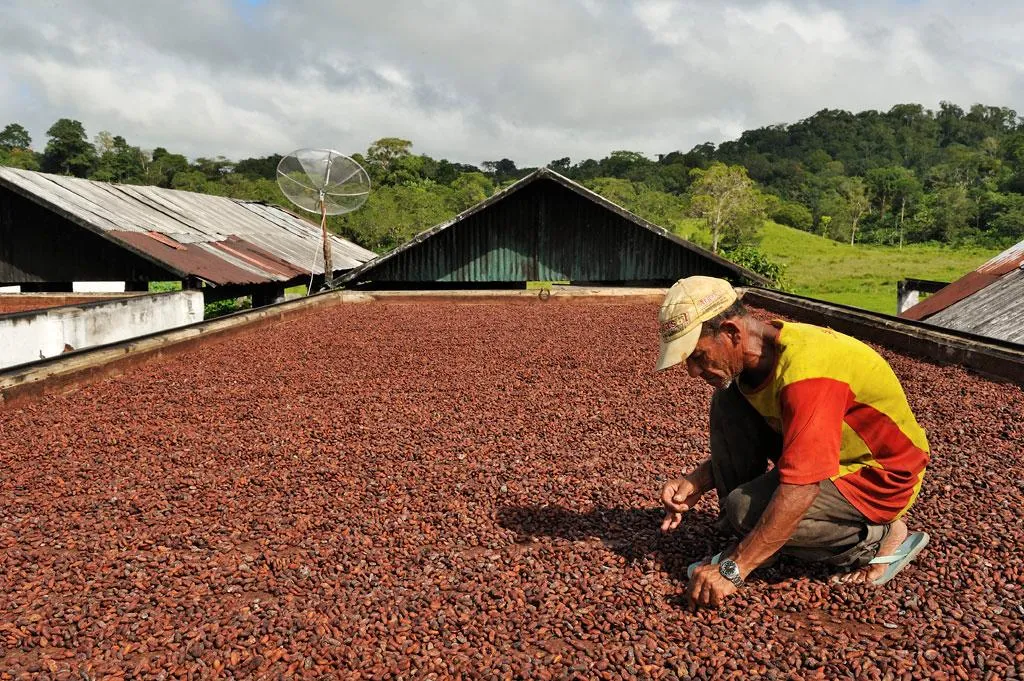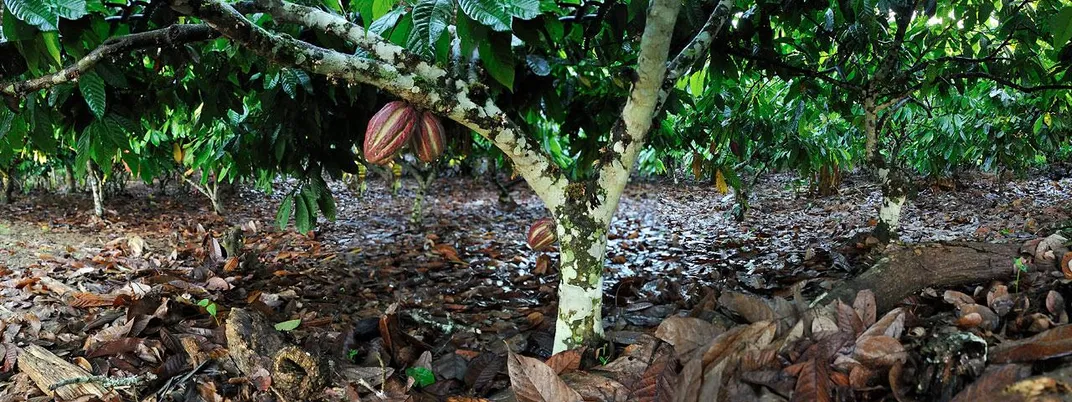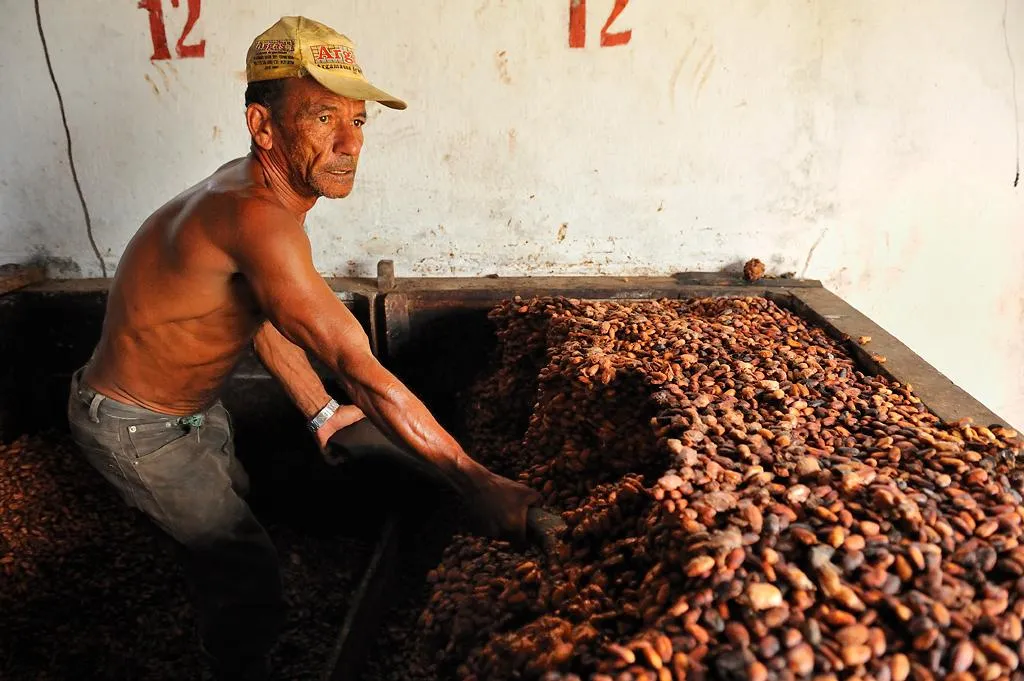The Economics of Chocolate
Before becoming a kiss, bar, or hot drink, cocoa gets shipped, stashed, smashed, and, most critically for producers and consumers alike, commodified
/https://tf-cmsv2-smithsonianmag-media.s3.amazonaws.com/filer/17/ea/17eace00-4763-42d4-b1c7-42cad9cf0c69/futures-chart.jpg)
Look at a graph of cocoa prices since Valentine's Day 2014, and you'll see a jagged line as ragged as a broken heart.
The price line includes plenty of peaks and valleys, but the sharpest came last September. The line jerked suddenly upward, plateaued at cocoa's highest price in several years, and then plummeted to its original level. It left an ascending spike of almost perfect symmetry. That spike was Ebola, converted into cocoa prices. (And the most recent drop resulted from declining demand for chocolate.)
Cocoa makes a long and winding journey from bean to bar. The crop starts in the farms of tropical nations, especially in West Africa, and travels through ports, shipping containers and processing plants. But before they can reach your bag of M&M's, cocoa beans also travel through an intangible dimension—the financial world of price graphs, futures contracts and commodity ETFs. Ever since the New York Cocoa Exchange was founded in 1925, cocoa has been bought and sold in abstract form.
Before we can peek into the financial world of cocoa, a tour of a typical farm. Cocoa requires tropical climate and shady conditions, which means that cocoa farms don't look much like wheat fields or orange orchards. Trees are grown under a canopy of taller trees, so many farms look like cultivated rainforest. On average, cocoa farms are small operations, around 4 hectares—the size of just 8 football fields. (The average farm in the US, by contrast, is around 95 hectares.) Though cocoa farms can generate relatively big profits, the long-term survival of some farms in question: Recent climate change predictions have made producers nervous, and the world's largest chocolate manufacturers are at work breeding heat- and drought-resistant trees.
Farm workers who harvest cocoa are, on average, extremely poor, with some below the World Bank poverty line of $1.25 per day. A few years ago, a German photographer Jochen Weber traveled to a Brazilian cocoa farm to take some pictures. He bought some Nutella—the sweetened, hazelnut chocolate spread—as gifts to the farm workers who showed him around. All of them considered it a great luxury, and some had hardly ever encountered the product before. “You can't work on a cocoa farm not knowing Nutella!” he remembers thinking. One worker, a woman named Leni, found it so delicious that that very day, she finished the entire container. “She said she couldn't stand it—it was so good.”
Almost all of the world's cocoa is grown in developing countries and consumed by industrialized countries. The top four producers—Ivory Coast, Nigeria, Ghana and Indonesia—are all in the bottom half of nations by per-capita GDP. More strikingly, the top ten countries ranked by chocolate consumed are all in the top 15 percent. Nine of those countries are in Europe. (In 2012, the United States was ranked 15th.)
It takes a long and complicated supply chain to manage a product that is consumed thousands of miles from where it's grown. “I always thought of it as this giant river trickling down to these ports,” says John Helferich, who directed research and development for the U.S. division of Mars, Inc. until 2005. In a country like Ivory Coast, small farmers first sell to middle men, who sort and transport big bags of beans to shipping centers like the port city of Abidjan.
From the port cities, global businesses start to dip their fingers in the cocoa jar. Middle men sell to international trading companies like Cargill and ADM, which ship the beans to port cities like Philadelphia and Rotterdam. The cocoa beans are still many steps away from becoming chocolate, but by this point, they've entered the financial world.
Commodities traders can participate in the cocoa market in a few ways, but the most common is with cocoa futures. A futures contract is sort of like a rain check: it allows the purchaser to secure a low price. If that price has increased one year later, the trader has a stash of discounted cocoa to resell for a profit. Unlike with a rain check, however, traders suffer the consequences if prices decline. If you buy 1 ton of cocoa futures and the price drops, you'll be stuck paying last year's higher price.
Commodities traders can work for food manufacturers, agricultural trading houses, and investment groups like hedge funds. Jonathan Parkman, who works at a trading house called Marex Spectron in London, says the cocoa world is a triangle of interested parties, all making different bets on the prices of cocoa. “Producers want stable high prices,” he explains. “Chocolate makers want stable low prices. The investor wants a trending market without really minding in which direction.”
In other words, farmers want to sell their crop at a premium, while chocolate companies want to get a good deal on their supply. Commodity traders don't care which side wins, as long as prices rise or fall. (They can make money from falling prices by short-selling futures contracts.)
As with all commodity trading, traders gain an edge by knowing more about market trends than their competition. “A lot of companies will be pod counting, so they'll go around trees and actually count the number of cocoa pods,” said Emile Mehmet, who is head of bulk commodities at a London-based research agency called Informa. Decades ago, large chocolate producers like Mars would send representatives on pod counting expeditions, in order to spot oncoming low yields in advance. These days, it's a common enough tactic that it only provides a slight edge. Other sources of cocoa-related intelligence: El Niño predictions, processing figures from cocoa grinders, and the quarterly earnings from big chocolate makers.
Cocoa prices are relatively volatile compared to commodities like corn or wheat. “A lot of the world's production is concentrated in a small part of the world,” says Mehmet. This means that local forces can have a global impact on prices. For example, the yearly Harmattan trade winds of West Africa can cause a dusty haze that hangs in the air for days, preventing cocoa pods from developing properly. According to cocoa producers in Ivory Coast, that's the case this year.
A trader who gets wind of news like that can buy cocoa futures, which will rise in value when smaller yields push up the price. In the past, cocoa prices have risen during fungal and insect disease outbreaks. In the future, cocoa prices could rise if climate change shrinks the area where cocoa can feasibly be grown. (On the other hand, climate change could also expand or simply shift cocoa-growing regions.) It's an awkward truth of commodities markets—and stock markets, too—that traders can make good money from bad news.
Which brings us back to Ebola. Last September, when the disease was spreading rapidly through Liberia and Sierra Leone, traders were closely following the news. If Ebola had spread to cocoa-producing regions, it might have decimated the labor force and interrupted the supply chain. As the graph of cocoa prices shows, investors—like grocery shoppers before a snowstorm—recognized the risk of Ebola and started buying cocoa. Prices spiked, and traders who were ahead of the game raked in some extra cash. When it became clear that Ebola wouldn't reach Ivory Coast, however, prices returned to their earlier levels.
So what are commodities markets good for, other than making money? Historically, they were created to allow producers to stabilize their supply. Let's say I sell milk, but my customers complain that milk prices spike every time a blizzard blows through Wisconsin. Futures help me secure a consistent price and sell a more dependable product. That's why big chocolate makers hire traders: They don't want their product's prices to spike and dive along with the price of cocoa. They are why chocolate bars don’t vary much in price – milk, sugar, and cocoa futures keep them consistent.
Over time, though, commodities have grown increasingly abstract, and speculators outside of the chocolate business have gotten in on the game. Some commodities traders might say this is a good thing, if it helps prices take into account real-world problems like weather and disease. John Helferich disagrees. “Commodity traders can sometimes tug around producers and farmers,” he said. A trader might buy cocoa because it's a relatively better deal than, say, gold. This would increase cocoa prices, whether or not cocoa crops are looking strong.
What traders, producers, and growers would likely agree on is that these days, very few people have a part in every step from bean to bar. Poor farm workers who harvest pods from cocoa trees may never taste produced chocolate—while investors who trade thousands of tons of cocoa may never see a raw cocoa bean. The gift and the burden of globalization is that while all this happens, consumers still get their chocolate.


